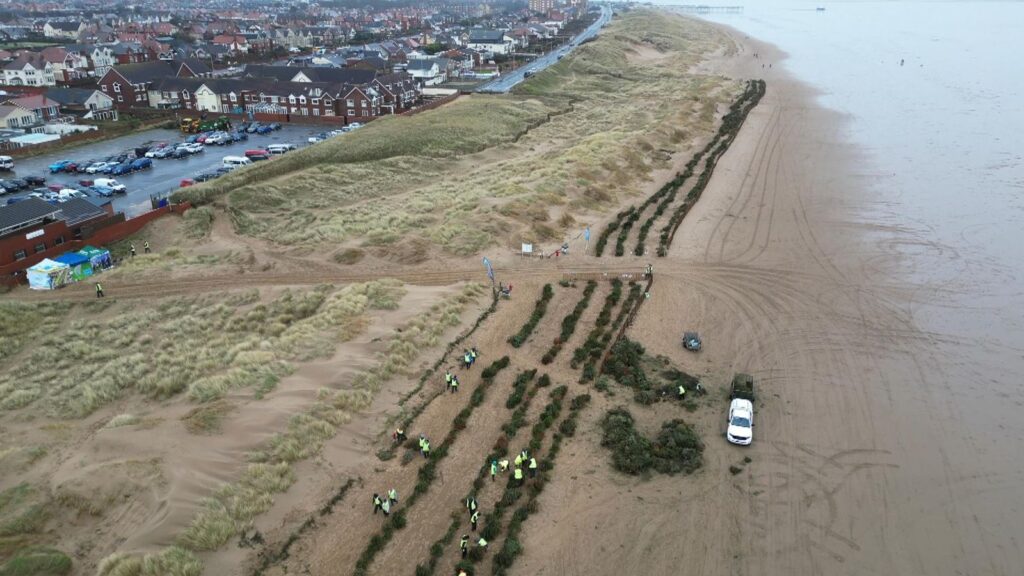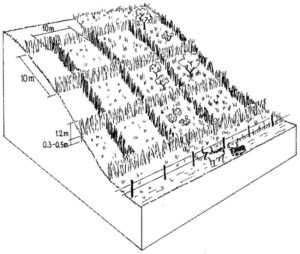Maintenance activities and inputs: As soon as vegetation cover is established on the denuded surfaces the dunes can again be used for grazing or for harvesting of herbs and fuelwood. The period and frequency of use should be determined in common agreement with all actors involved. The ELD recommends at least a 2- or 3-year protection period. Communities should also organize themselves collectively to take ownership of several fixation activities, such as ensuring regular surveillance.
Land Rights: Review the land rights and responsibilities to allow the people to take ownership of the activities, and to ensure no conflict occurs between herders and stabilization practitioners.
Materials required
- Palisade material, e.g. dried millet stalk, brushwood, old christmas trees
- Digging tools, e.g. shovel or digging machine
- Fencing material (only for thatching with millet stalk palisades)
- Rope to create millet stalks(only for thatching with millet stalk palisades)
Steps of Implementation
- Location: Firstly, map out the area that is subjected to dune destabilization and is in need of protection. Avoid disturbing sensitive vegetation or habitats. Consult local authorities or environmental experts to ensure you’re not impacting protected areas or species. The barrier should be placed parallel to the sealine or perpendicular to the prevailing wind direction. The barrier should generally be 2 to 4 meters away from the present dune vegetation.
2.1 Construction of a thatch with old (Christmas) trees:
- Collection of materials: Old trees, like used Christmas trees, can be used to create a barrier against the wind to promote dune stabilization and growth. The old trees can be collected after the Christmas period, ea. with help from the local municipality.
- Digging: To create the barrier, dig a hole in a line parallel to the shoreline (with a minimum depth of 50 centimeters) by using a shovel or digging machine. Sometimes multiple lines are being dug. This depends on the available space for the formation of new dunes.
- Placement: The trees can be placed in the hole closely next to each other. In this way a continuous barrier is created. After placing the trees make sure to fill up the empty space with sand again and make sure to firm the sand.

(source)
2.2 Construction of a thatch with millet stalk palisades:
- Harvest millet stalks: Firstly millet stalks should be collected preferably from local sources if possible.
- Bundling millet stalks: The millet stalks should be bundled together so they increase strength and are able to form a continuous palisade. For 1 hectare 2,000 bundles are needed. One bundle should weigh 6 to 10 kg.
- Fencing: Firstly the area should be closed off by a wire fence to prevent human disturbance and grazing.
- Digging: dig the square grids of 10 by 10 meters. Make sure to dig the holes around 30 to 50 centimeters deep into the ground.
- Palisades placement: The bundled millet stalks can now be placed in the holes and form a palisade. The palisades should have a height of around 1.2 meters and should form a continuous barrier.
- Dune grass planting (optional): When this intervention is combined with dune grass planting, seedlings can be planted in the middle of the square grids.

(source)
3. Maintenance & monitoring: Thatching requires consistent maintenance to address erosion damage, public wear, and to expand coverage as the dunes naturally shift. This work can be done year-round, although spring is preferred when combined with transplanting. On exposed shorelines, storms may wash away thatching entirely.
This intervention contributes to:

COSTS
|
Thatching with (Christmas) trees |
Thatching with millet stalk palisades |
| Establishment costs |
3 - 25 $ / m.
When using donated Christmas trees, the establishment costs are very low. |
1450 US $ / ha (including the costs of fencing) |
| Labour time |
Constructing the barrier is time and labor intensive. When performed in large groups (of volunteers), several rows of around a hundred meters can be achieved within a few days. |
Labor per ha includes installing wire fence (16 person days), collecting and transporting millet stalks and installing palisades (175 person days), sowing of herbaceous plants (2 person days), planting tree/shrub species (6 person days) |
| Maintenance costs |
Low - bi-annual monitoring |
50 US $ / ha, which includes guarding the area and replacing dead plants |
Based on information from the UK Department of Environment, Food & Rural Affairs and WOCAT.
- Flyde Sand Dunes Project in Lancashire, UK
Each year along the Fylde Coast in the UK, old Christmas trees are collected and used to strengthen coastal defences for communities like Lytham, St Anne’s, and Blackpool. These trees are strategically placed on beaches with branches oriented toward prevailing winds, which helps trap sand as it blows ashore. Over time, this trapped sand accumulates and supports the formation of new dunes, creating a natural barrier that protects against sand erosion and sea encroachment. The trees are donated by locals to designated collection points and then planted along the coast in an annual three-day event, usually held in early February. This community-driven approach not only reuses Christmas trees sustainably but also enhances the natural resilience of the coastline.
- Sand dune stabilization with millet stalk palisades in the Sahelian zone of Niger
In Niger's Sahel region, sand dunes encroach on agricultural and pastoral lands, posing a threat to local communities. This often occurs when previously stable dunes become mobile due to vegetation loss from unfavorable climates and overuse for grazing and fuelwood collection. To counteract this, sustainable dune stabilization is achieved by regenerating vegetation on the mobile dunes, protected by mechanical methods. The approach combines three main measures: (1) fencing and guarding areas to prevent use until vegetation is restored (usually 2–3 years), (2) building millet stalk palisades in a checkerboard pattern to act as windbreaks, which control sand movement and decompose as vegetation takes over, and (3) planting resilient species like Acacia and Prosopis to stabilize the soil. Once vegetation is established, dunes can be sustainably used for grazing and fuelwood. Between 1991 and 1995, over 250 hectares of dunes were stabilized in this way, with support from the Projet de Développement Rural de Tahoua (PDRT). However, high fencing costs limited further expansion after 1995. As an alternative, "social fencing" – agreements among stakeholders to limit access during critical periods – has shown potential to protect these areas at no financial cost.

